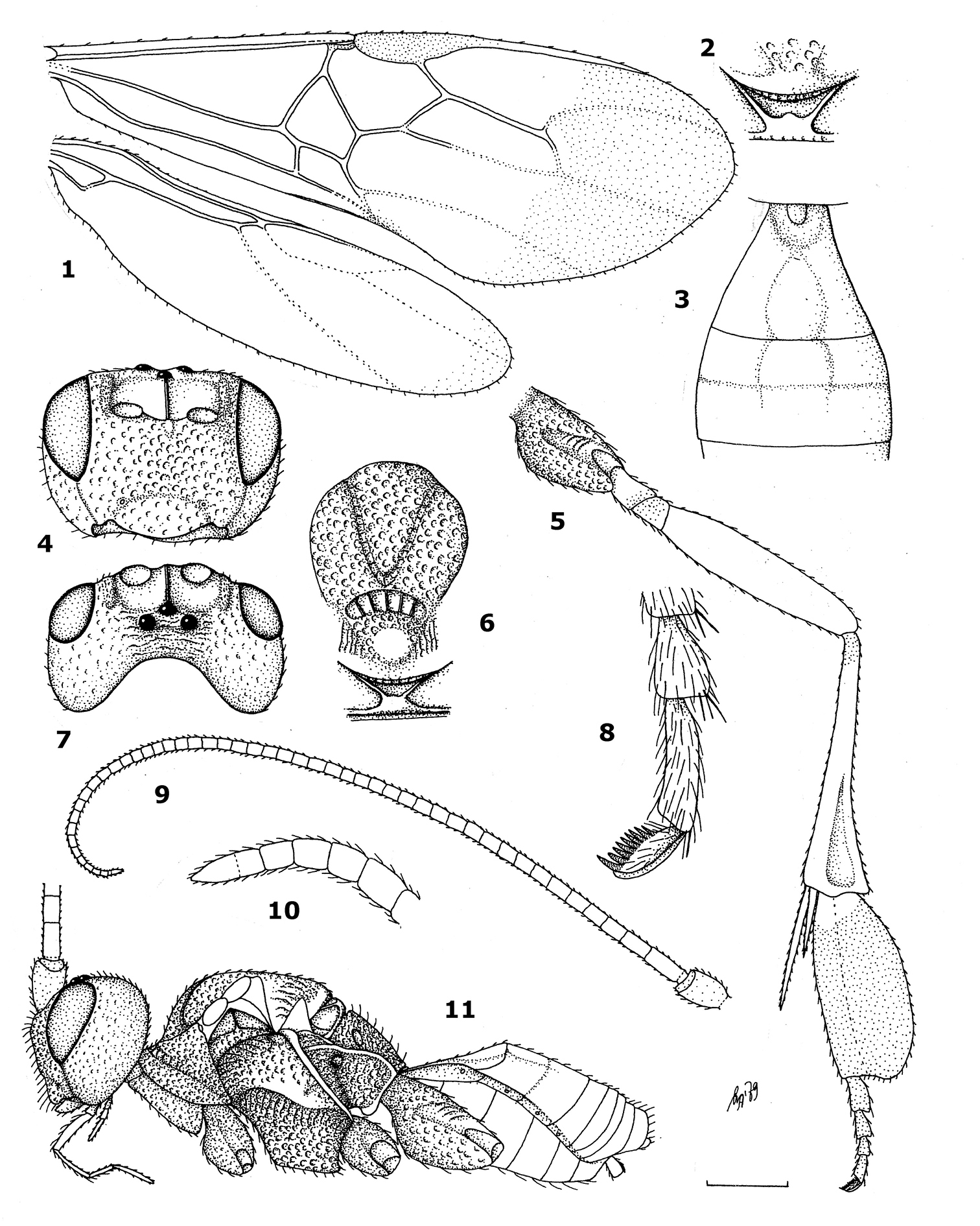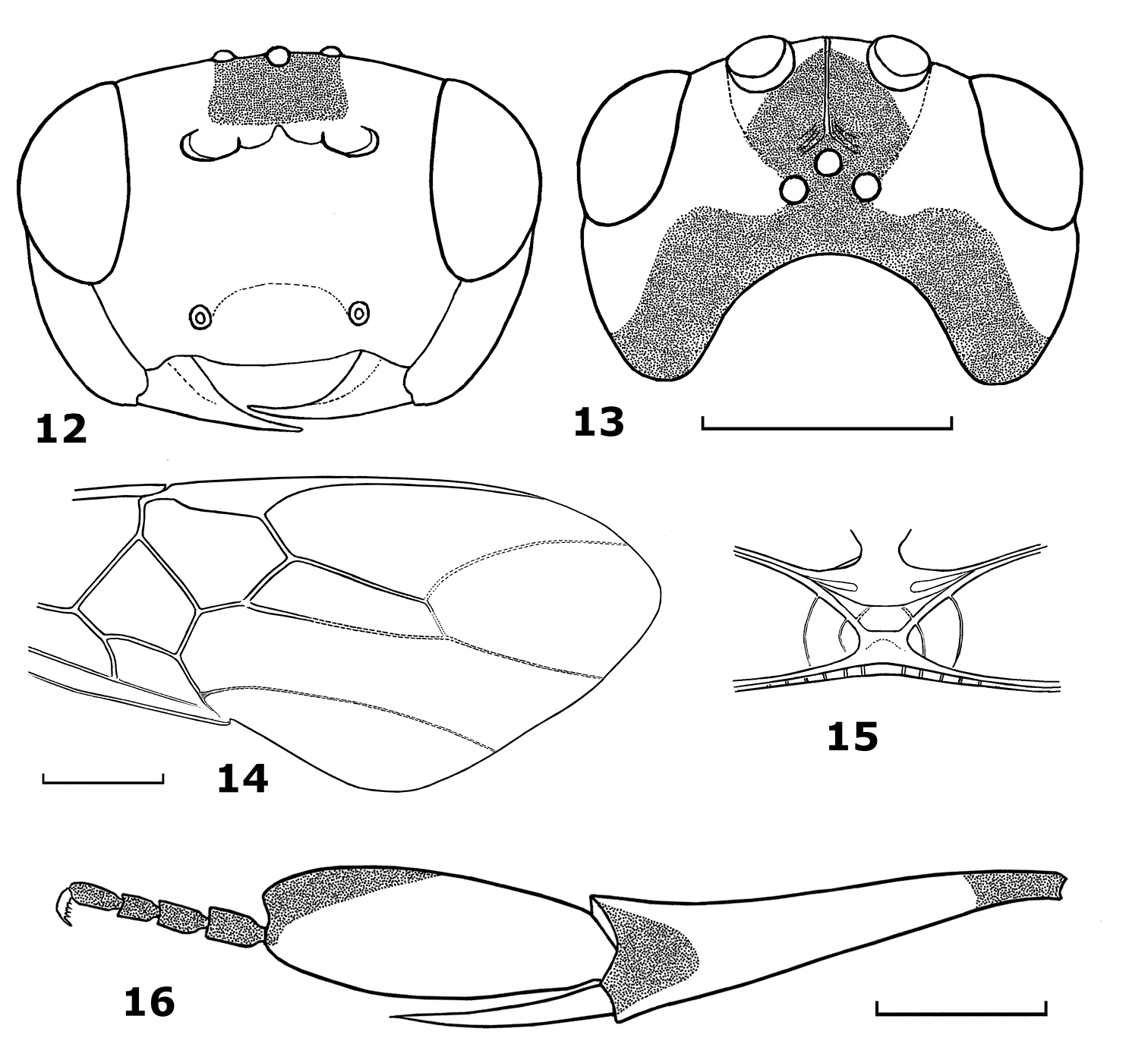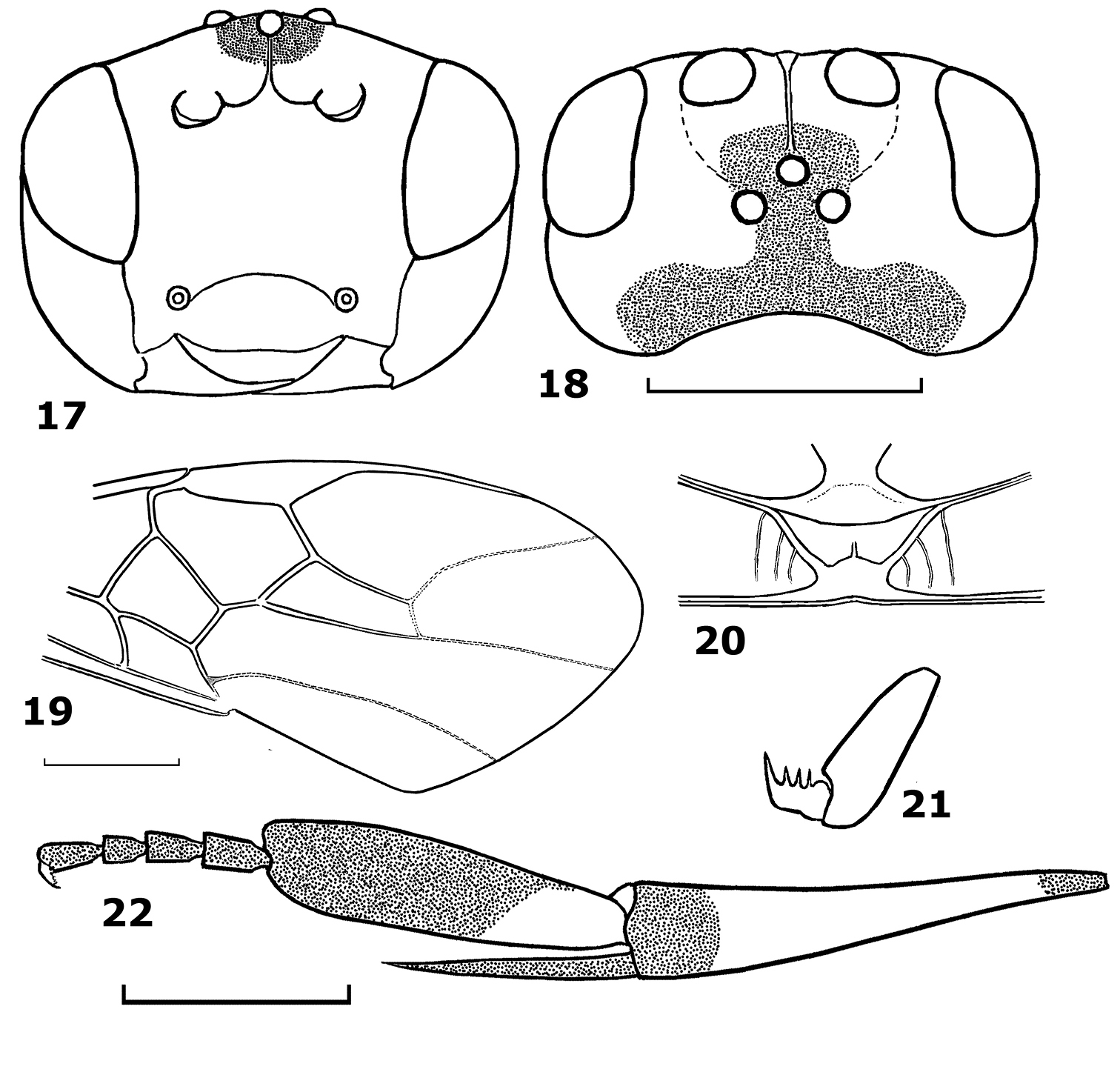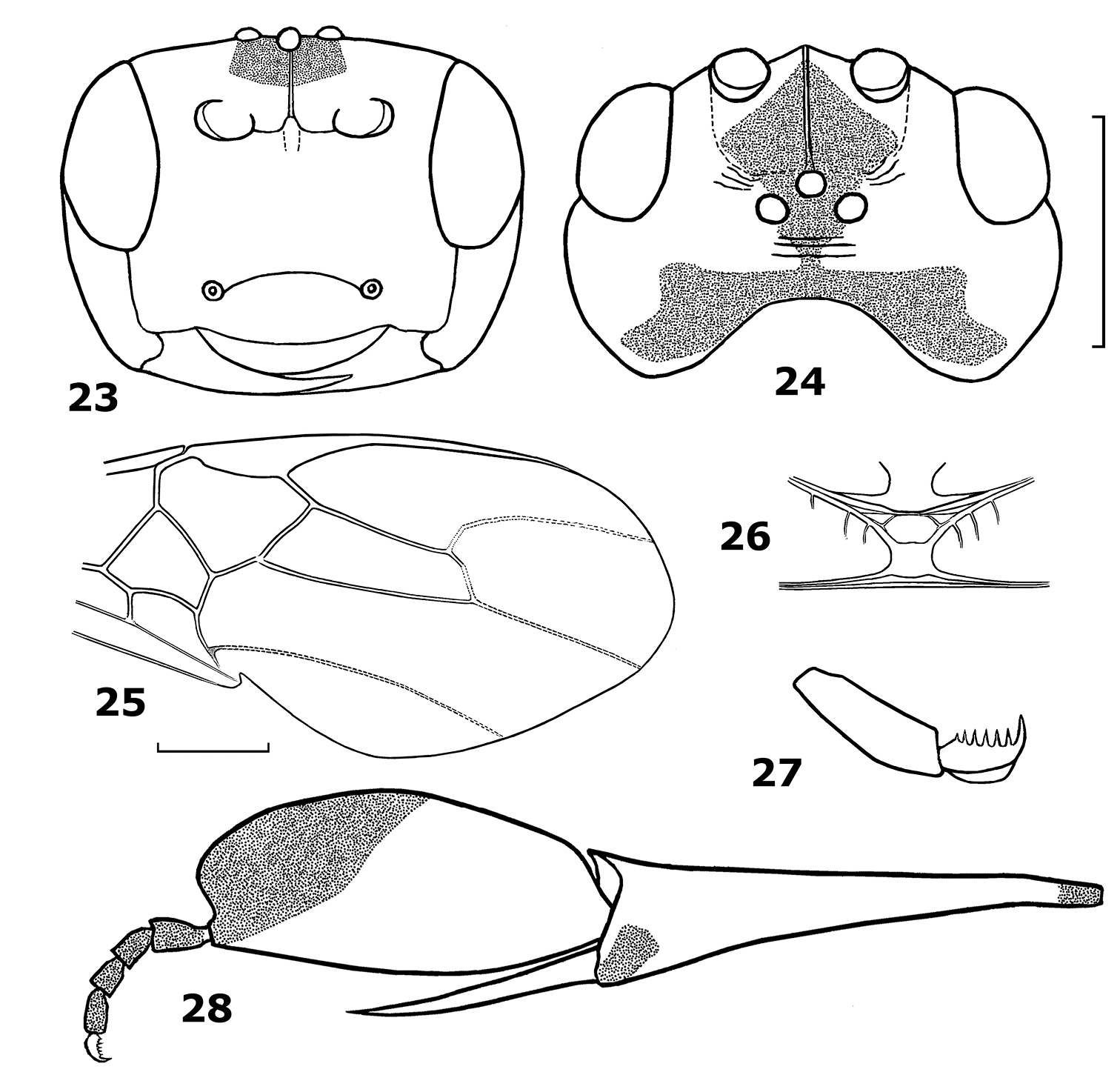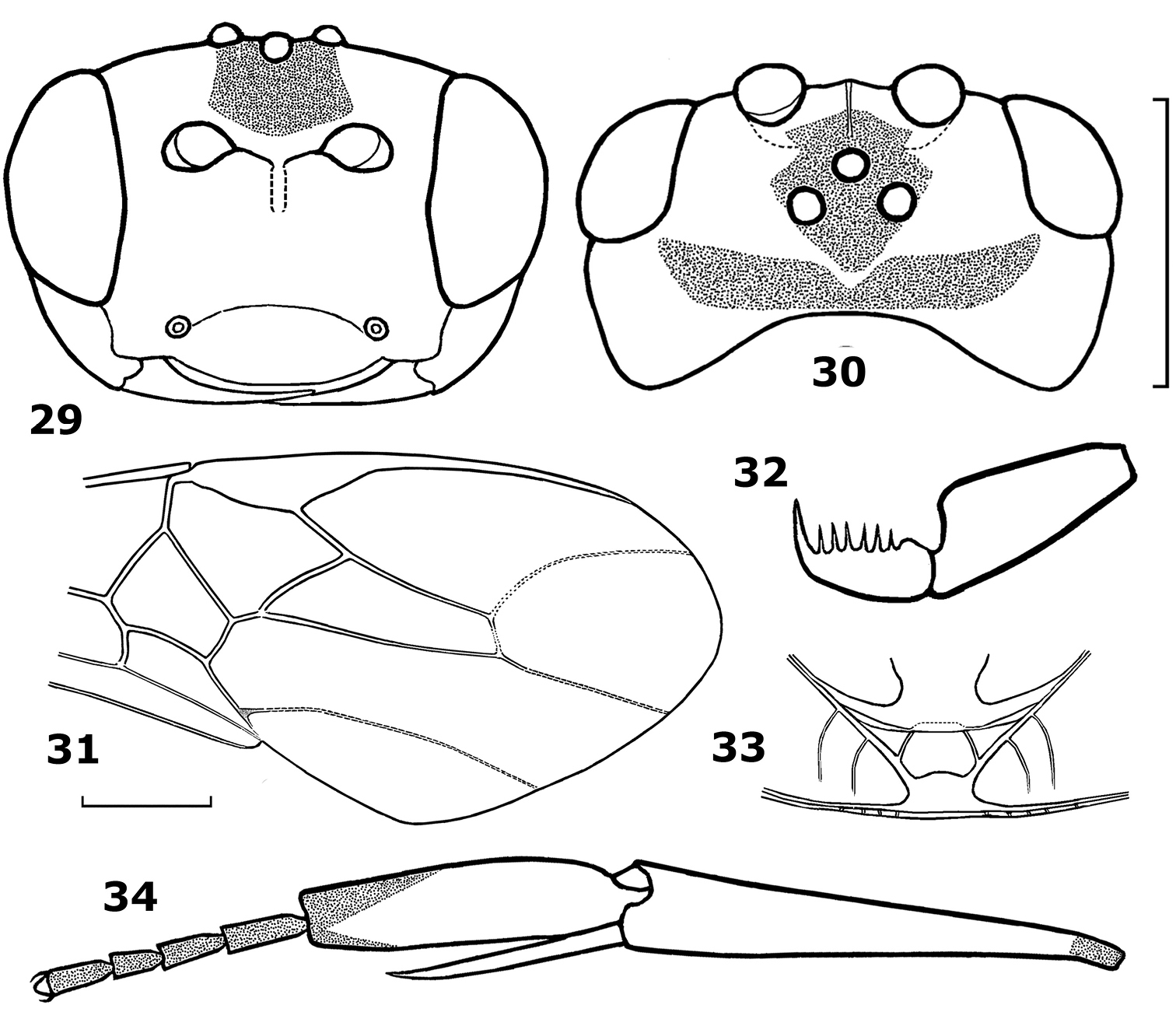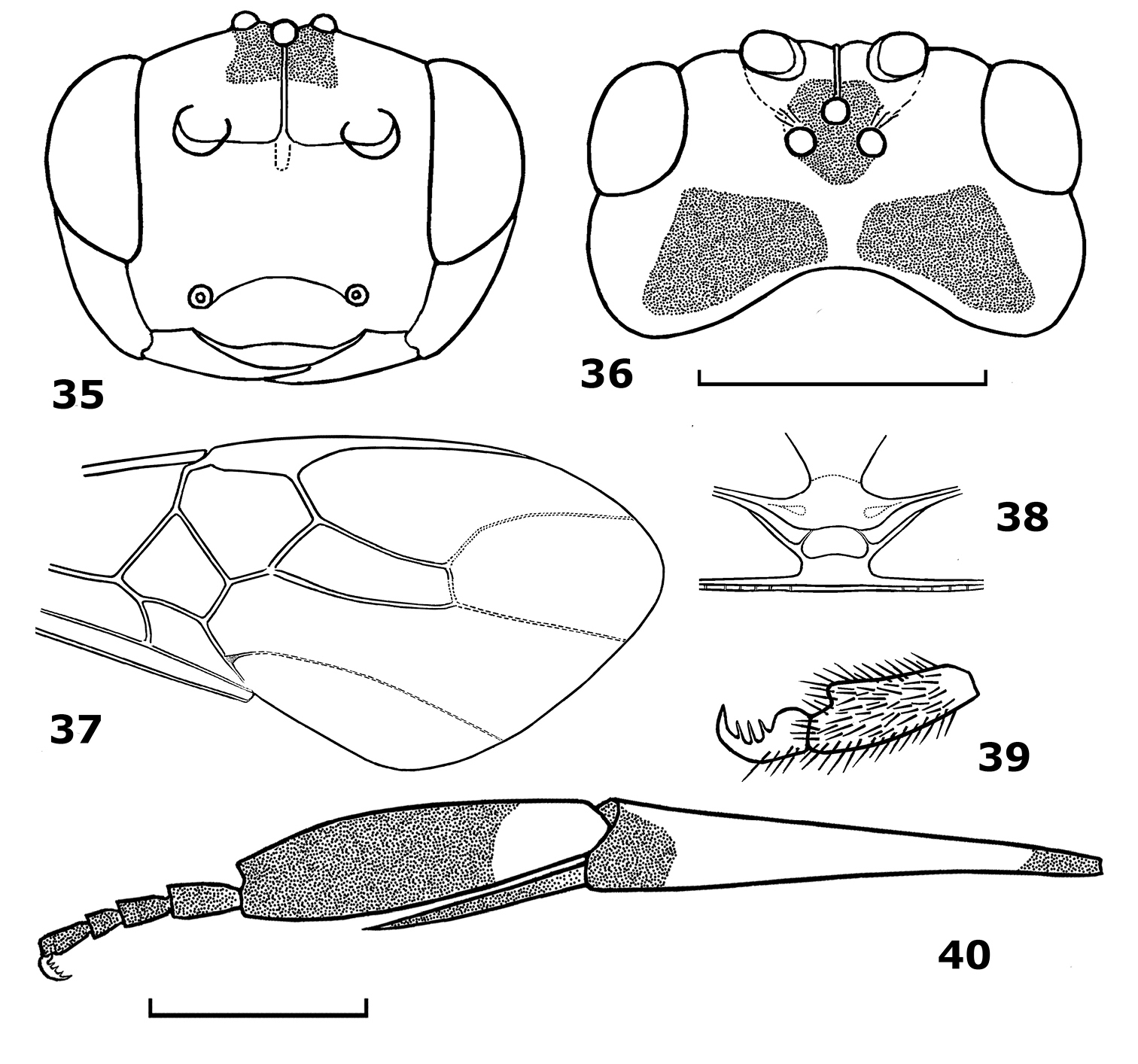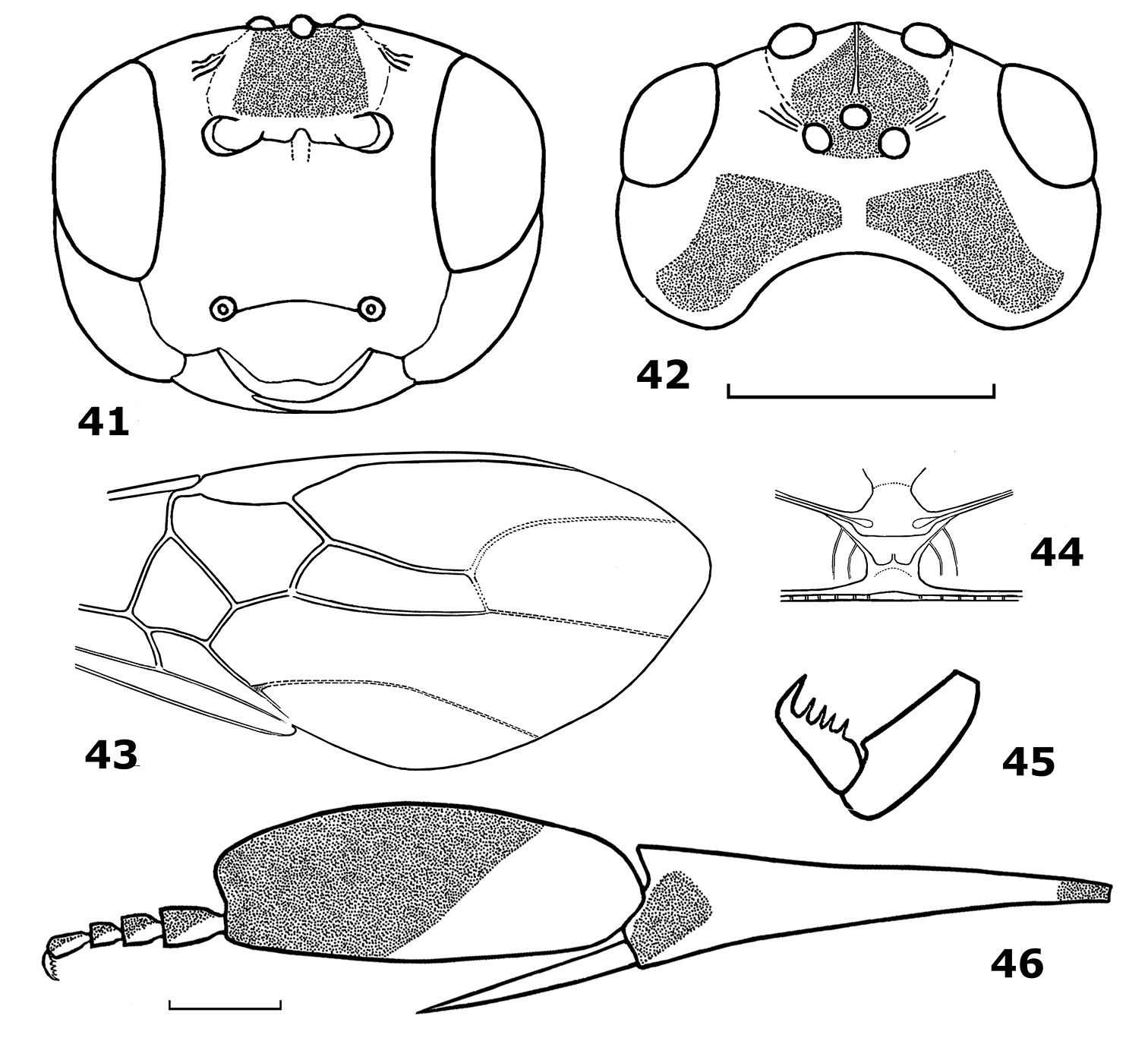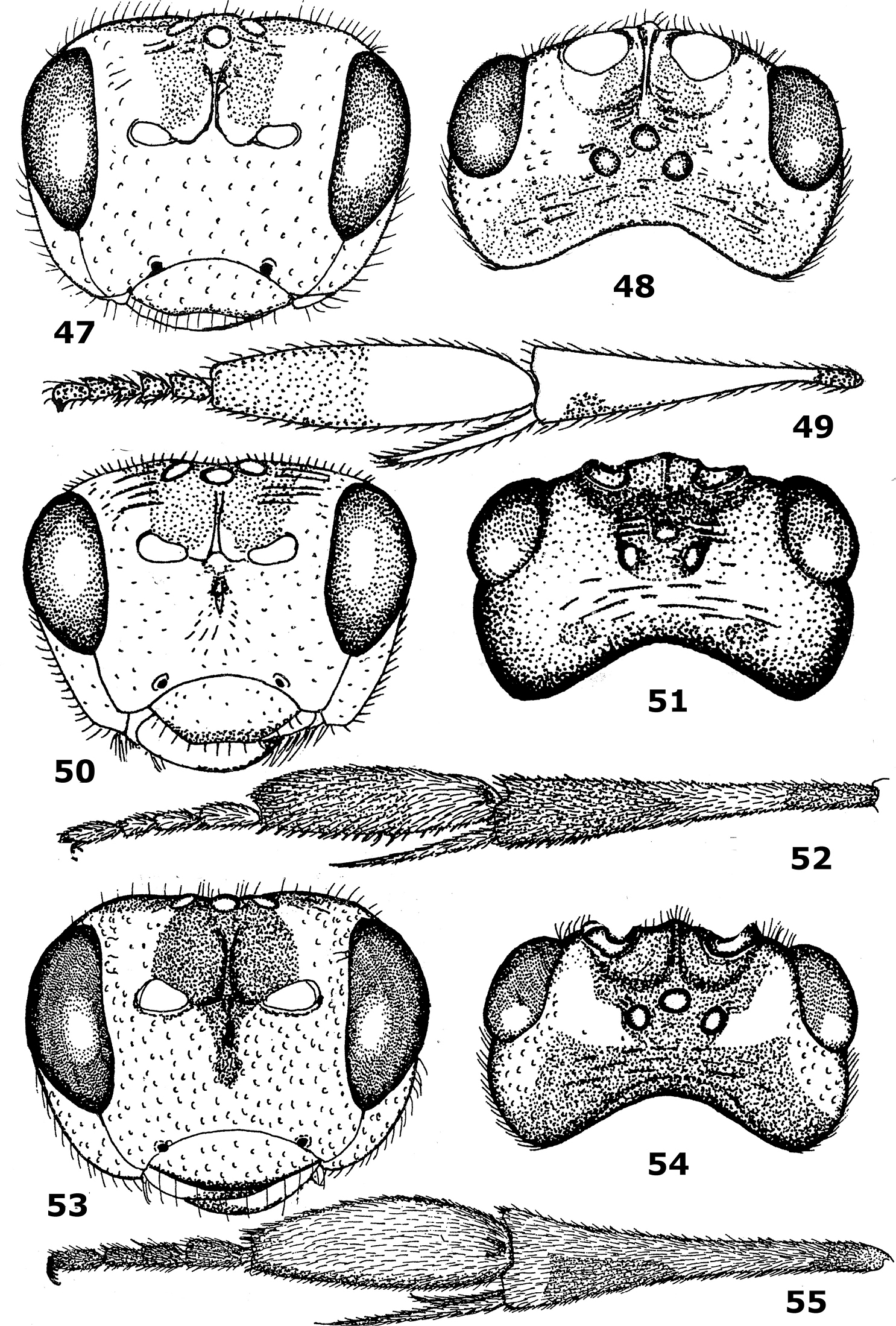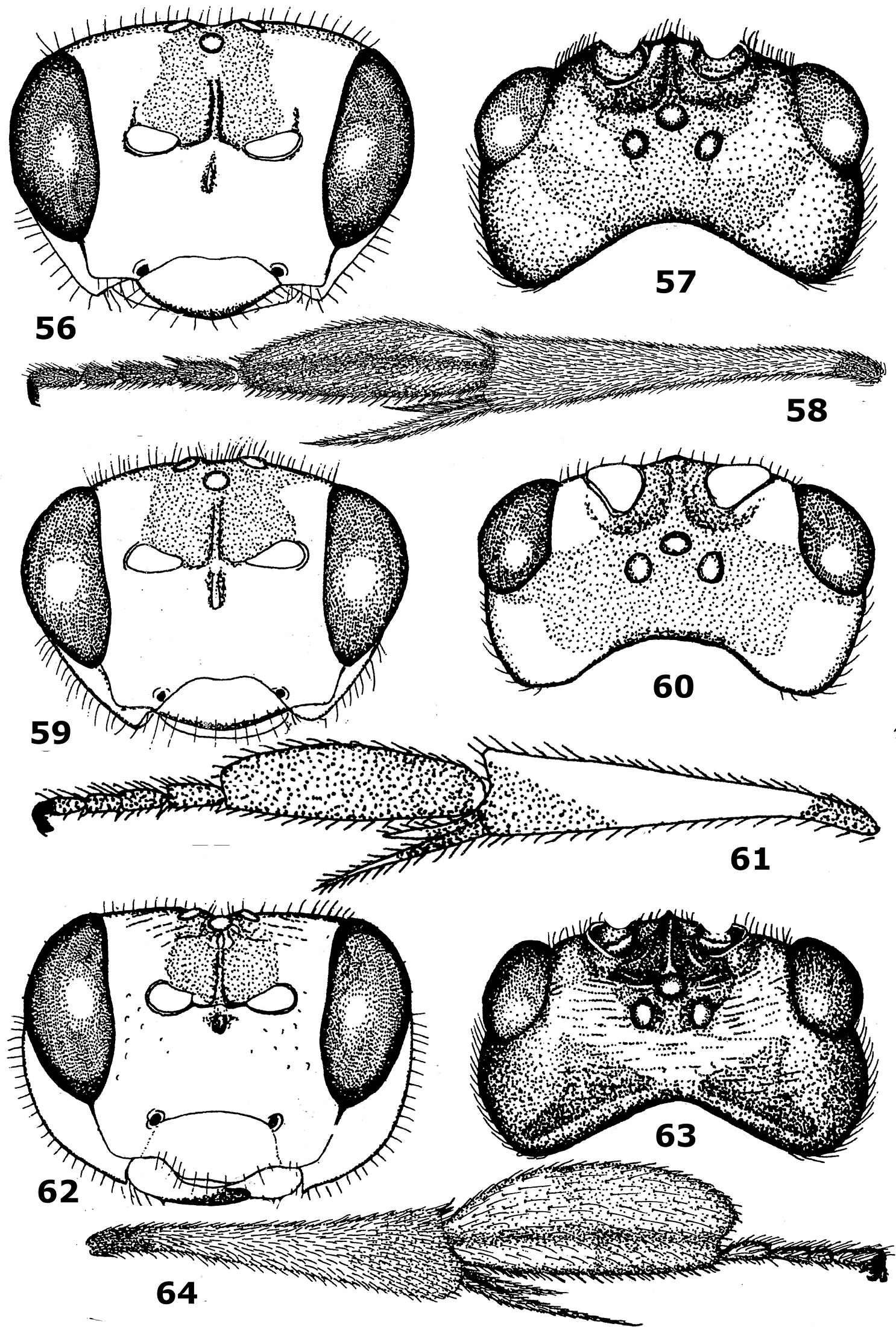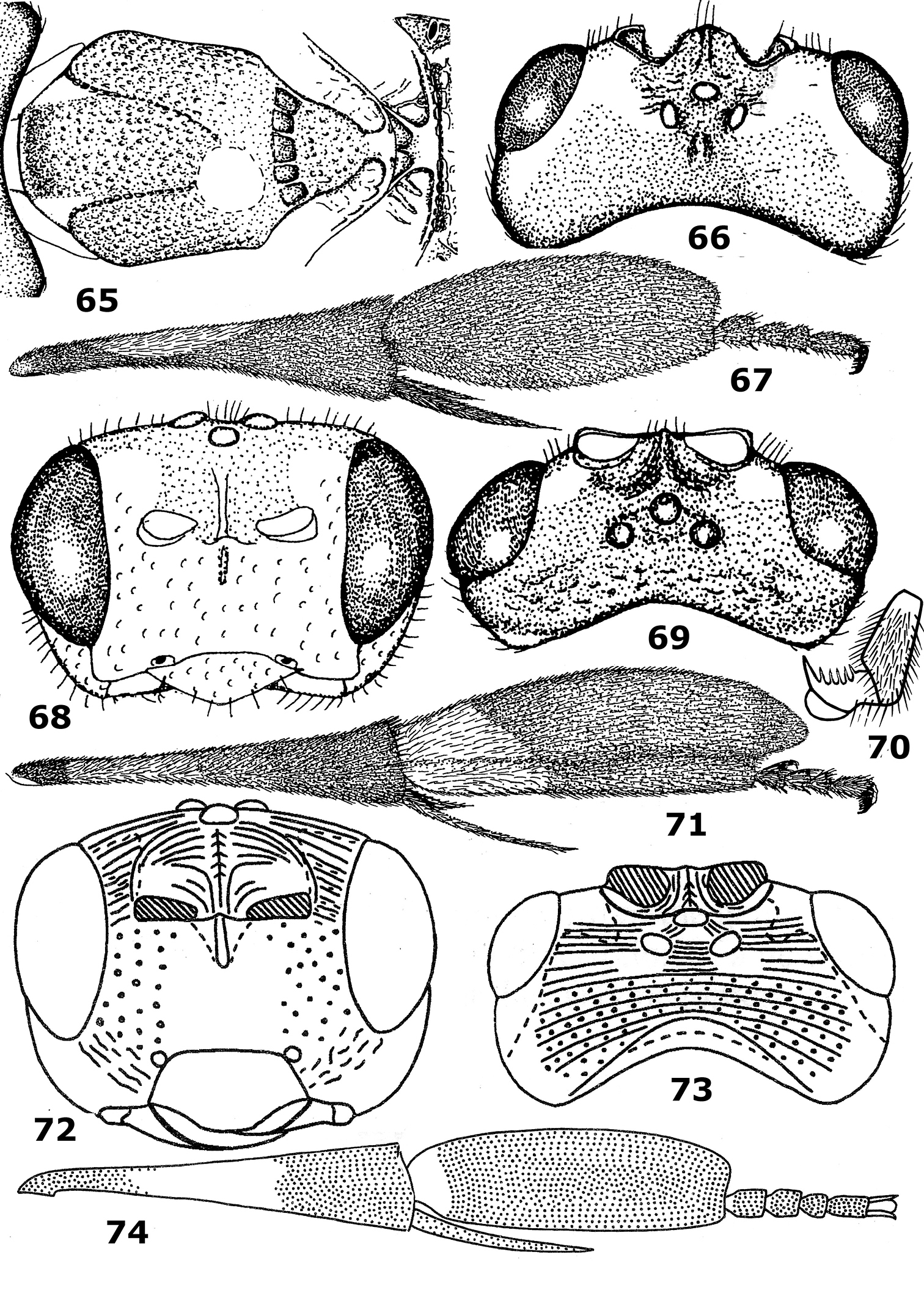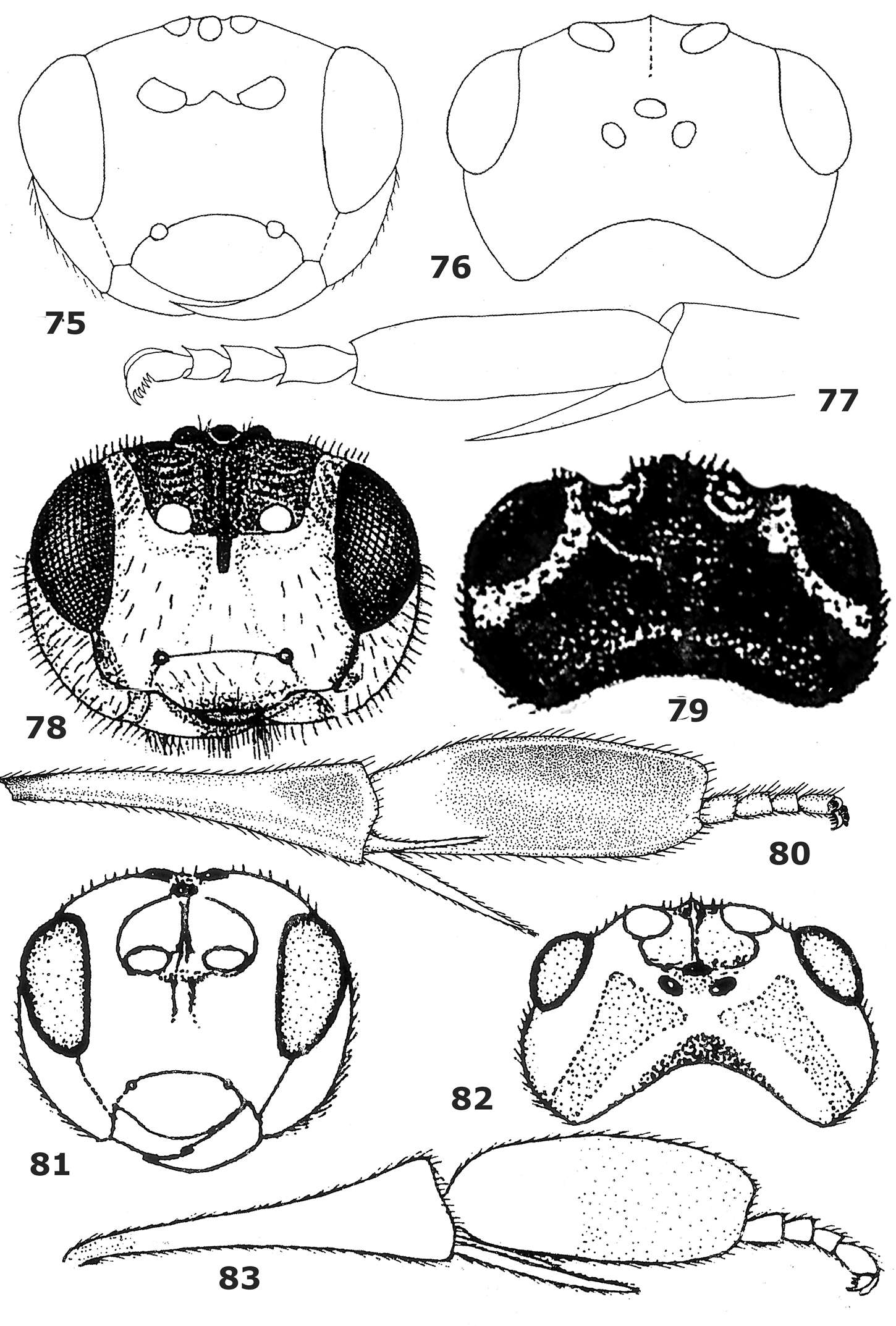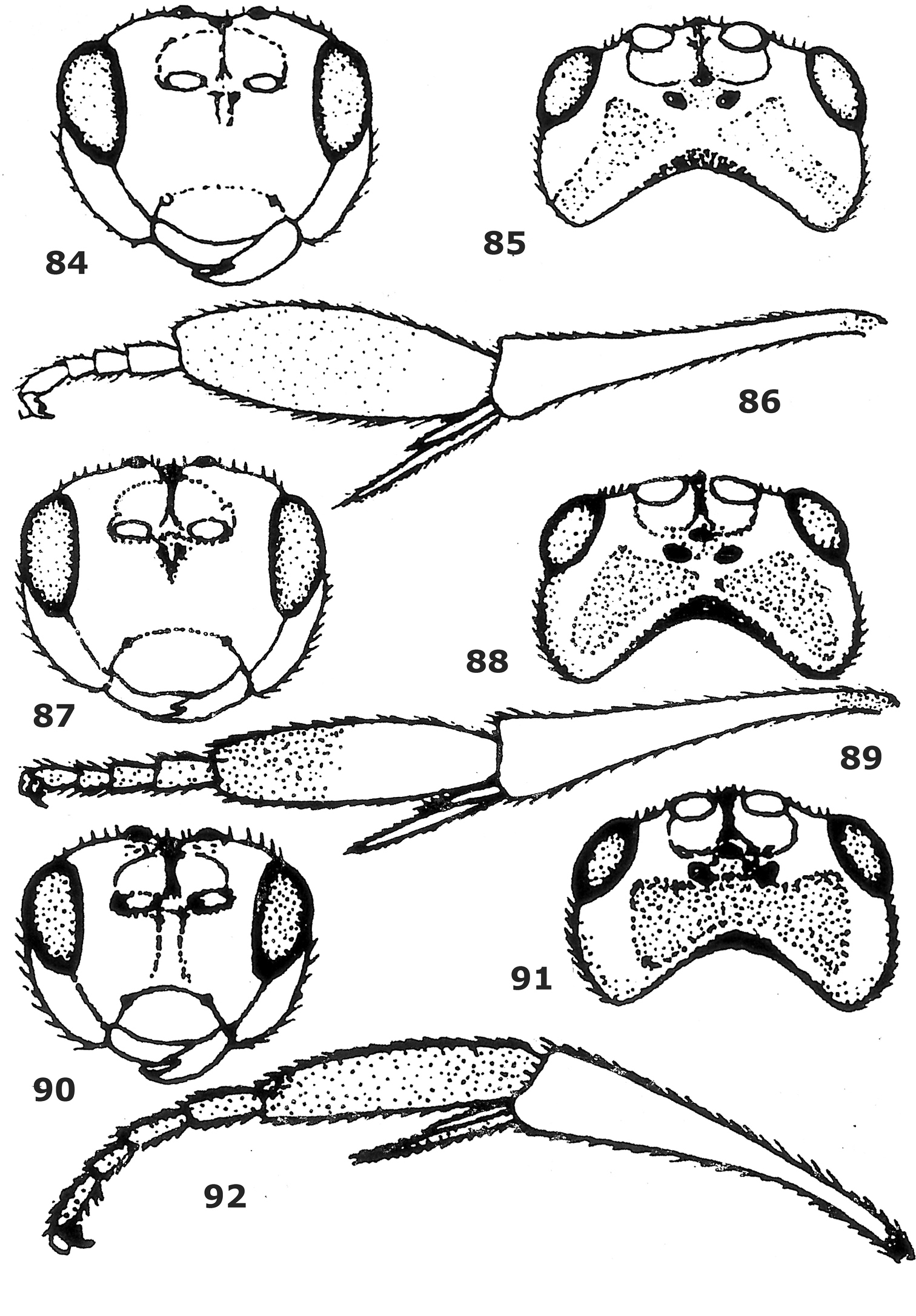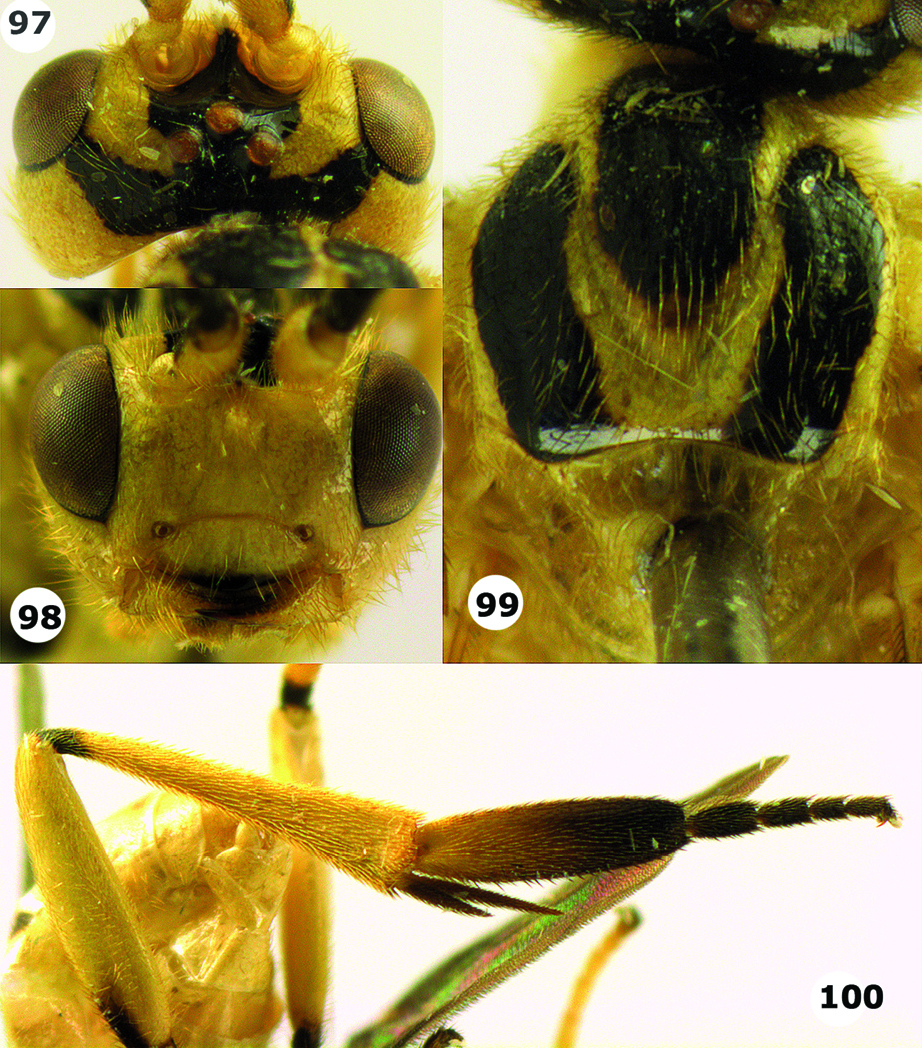(C) 2011 Khuat Dang Long. This is an open access article distributed under the terms of the Creative Commons Attribution License, which permits unrestricted use, distribution, and reproduction in any medium, provided the original author and source are credited.
For reference, use of the paginated PDF or printed version of this article is recommended.
The Oriental and East Palaearctic genus Hartemita Cameron, 1910 (Braconidae: Cardiochilinae) is recorded for the first time from Vietnam. Sixteen species of the genus Hartemita are currently recognized from Oriental and East Palaearctic regions. One species is newly recorded for Vietnam, Hartemita singaporensis (Mao, 1945)and six new species from Vietnam are described and illustrated: Hartemita coffeana sp. n., Hartemita daklaka sp. n., Hartemita khuatbaolinhae sp. n., Hartemita similis sp. n., Hartemita maculata sp. n. and Hartemita vietnamica sp. n. A key to species of the genus Hartemita Cameron is included.
Braconidae, Hartemita, new species, key, Oriental, Vietnam
The small genus Hartemita
Cameron, 1910 (Braconidae: Cardiochilinae) is comparatively rare in
collections and easily recognizable by its enlarged hind basitarsus (Figs 5, 22, 55, 83, 100).
In this respect they resemble stingless bees (Meliponini) which occur
over most of its range and as suggested by one of the referees this may
be not coincidence. It has an Oriental and East Palaearctic
distribution, but was unknown from Vietnam (
Two recent and larger collections of Cardiochilinae from Vietnam are used for this revision: the Braconidae collection in the Institute of Ecology & Biological Resources (IEBR) at Hanoi (assembled by the first author) and the Netherlands Centre for Biodiversity Naturalis collection (RMNH) at Leiden (assembled during five RMNH-IEBR expeditions in Vietnam).
For recognition of the subfamily Cardiochilinae, see
http://species-id.net/wiki/Hartemita
Figs 1–86Largely unknown; only one species (Hartemita buteae) has been reared from an unidentified Noctuid larva.
Checklist and distribution
Hartemita basilaris Dangerfield & Austin, 1990, from Indonesia
Hartemita bruneiensis Dangerfield & Austin, 1990, from Brunei and East Malaysia
Hartemita buteae Ahmad & Shujauddin, 2004, from India
Hartemita chapini (Mao, 1945), from Philippines and Malaysia
Hartemita chinensis Chen, He & Ma, 1998, from China
Hartemita coffeana sp. n., from Vietnam
Hartemita daklaka sp. n., from Vietnam
Hartemita excavata Chen, He & Ma, 1998, from China and Vietnam
Hartemita flava Chen, He & Ma, 1998, from China
Hartemita khuatbaolinhae sp. n., from Vietnam
Hartemita latipes Cameron, 1910, from Indonesia, East and West Malaysia
Hartemita maculata sp. n., from Vietnam, China and Nepal
Hartemita muirii (Fullaway, 1919), from Philippines and Japan
Hartemita nigrotestacea Belokobylskij & Ku, 2000, from Japan and South Korea
Hartemita punctata Chen, He & Ma, 1998, from China
Hartemita rhadinotarsa Dangerfield & Austin, 1990, from India, Indonesia and Nepal
Hartemita rudis (Mao, 1945), from Philippines
Hartemita similis sp. n., from Vietnam
Hartemita singaporensis (Mao, 1945), from Singapore, Laos, West and East Malaysia and Vietnam
Hartemita spasskensis Belokobylskij, 2005, from Far East Russia
Hartemita townesi Dangerfield & Austin, 1990, from China (Taiwan)
Hartemita vietnamica sp. n., from Vietnam
Key to species of the genus Hartemita Cameron
| 1 | Maximum width of hind basitarsus 1.2–1.6 times apical width of hind tibia and dorsally convex (Figs 5, 28, 46, 64, 67, 71, 86); but sometimes weakly so (Figs 80, 83); if 1.2 times then hind basitarsus 3.8–6.0 times as wide as second hind tarsal segment (Figs 64, 67, 80, 83) | 2 |
| – | Maximum width of hind basitarsus 0.8–1.1 times apical width of hind tibia and dorsally nearly straight (Figs 22, 52, 55, 58, 61, 77, 89, 92), but rarely slightly convex (Fig. 16); if 1.1 times then hind basitarsus 2.8–3.5 times as wide as second hind tarsal segment (Figs 40, 49, 74) | 11 |
| 2 | Dorso-apically hind basitarsus strongly protruding, beyond apex of second tarsal segment (Fig. 71); scutellum distinctly convex; maxillary palp 0.7–0.8 times as long as height of head; [head weakly excavate medio-posteriorly in dorsal view; hind tibial spurs yellowish-brown]; Singapore, East and West Malaysia, Laos, *Vietnam | Hartemita singaporensis (Mao, 1945) |
| – | Dorso-apically hind basitarsus weakly or not protruding, not surpassing middle of second tarsal segment (Figs 5, 28, 46, 64, 67, 86); scutellum slightly convex or flat; maxillary palp 1.0–1.5 times as long as height of head | 3 |
| 3 | Ventral margin of clypeus curved medially (Figs 4, 23, 81, 84); hind basitarsus comparatively wide apically (Figs 5, 28, 83), but in Hartemita chinensis less so (Fig. 86) | 4 |
| – | Ventral margin of clypeus more or less concave or straight medially (Figs 41, 62, 78); hind basitarsus comparatively wide apically (Figs 46, 64, 67, 80) | 8 |
| 4 | Maxillary palp about 1.3 times as long as height of head; hind basitarsus 2.3–2.5 times as long as wide, 4.4–5.0 times as wide as second tarsal segment and 1.4–1.5 times as long as width of apex of hind tibia (Figs 5, 28, 83); propleuron entirely yellow; hind coxa with one black spot | 5 |
| – | Maxillary palp about as long as height of head; hind basitarsus 2.8–3.0 times as long as wide, 3.6 times as wide as second tarsal segment and about 1.2 times as long as width of apex of hind tibia (Fig. 86); propleuron with a blackish spot posteriorly; hind coxa with two black spots; [mesosternum black; third hind tarsal segment of female 1.2–1.3 times longer than wide]; Oriental China | Hartemita chinensis Chen, He & Ma, 1998 |
| 5 | Hind basitarsus about 2.3 times as long as remaining tarsal segments and 1.2 times as wide as apex of hind tibia (Fig. 83); third hind tarsal segment of female slightly longer than wide; mesosternum yellow; scutellar sulcus with 3 carinae; hind tarsal claws with 3–4 teeth; Oriental China | Hartemita flava Chen, He & Ma, 1998 |
| – | Hind basitarsus about 1.8 times as long as remaining tarsal segments and 1.3–1.4 times as wide as apex of hind tibia (Figs 5, 28); third hind tarsal segment of female about twice as long as wide; mesosternum black; scutellar sulcus with 5–6 carinae; hind tarsal claws with 5–8 teeth | 6 |
| 7 | Hind tarsal claws with 8 large teeth (Fig. 8); face finely punctate; hind basitarsus largely blackish (Fig. 5); temples parallel-sided (Fig. 7) and slightly punctate; Philippines, Japan | Hartemita muirii (Fullaway, 1919) |
| – | Hind tarsal claws with 5 large teeth (Fig. 27); face rugose-punctate; hind basitarsus only apically blackish (Fig. 28); temples rather bulging (Fig. 23), roughly punctate dorsally and rugose-punctate ventrally; Vietnam | Hartemita khuatbaolinhae sp. n. |
| 8 | Second-fourth hind tarsal segments slender, distinctly longer than wide (Fig. 64); dorsal side of hind basitarsus distinctly more curved than nearly straight ventral side and with a rather distinct apical prominence (Fig. 64); hind femur yellow; [posterior half of notauli widely crenulate; frons entirely smooth]; Oriental China, Nepal | Hartemita townesi Dangerfield & Austin, 1990 |
| – | Second-fourth hind tarsal segments robust, slightly longer than wide (Figs 46, 67, 80); dorsal side of hind basitarsus similar to ventral side and truncate apically, without apical prominence (Figs 46, 67, 80); hind femur largely dark brown or black dorsally | 9 |
| 9 | Hind basitarsus elliptical (Fig. 67); face distinctly punctate; mesopleuron below precoxal sulcus coarsely punctate; basal and apical quarter of hind tibia and largely spurs dark brown (Fig. 67); Brunei, *East Malaysia | Hartemita bruneiensis Dangerfield & Austin, 1990 |
| – | Hind basitarsus nearly parallel-sided (Figs 46, 80); face punctulate or sparsely punctate; mesopleuron below precoxal sulcus rugulose-punctulate or smooth; hind tibia mainly and spurs yellowish-brown (Figs 46, 80) | 10 |
| 10 | Head in dorsal view comparatively short and occiput weakly concave (Fig. 79); pronotum coarsely rugose-striate; POL 1.2–1.3 times diameter of posterior ocellus; dark part of hind basitarsus close to base of basitarsus (Fig. 80); mesopleuron below precoxal sulcus densely rugulose-punctulate; Japan, South Korea | Hartemita nigrotestacea Belokobylskij & Ku, 2001 |
| – | Head in dorsal view comparatively long and occiput distinctly concave (Fig. 42); pronotum largely smooth except for median groove; POL 1.6 times diameter of posterior ocellus; dark part of hind basitarsus distinctly removed from base of basitarsus (Fig. 46); mesopleuron below precoxal sulcus smooth; Vietnam | Hartemita vietnamica sp. n. |
| 11 | Ventral margin of clypeus more or less curved medio-ventrally (Figs 75, 90) and hind basitarsus 0.8 times wider than apex of hind tibia (Figs 77, 92) and 2.2–2.3 times wider than second hind tarsal segment | 12 |
| – | Hind basitarsus 0.9–1.1 times wider than apex of hind tibia (Figs 16, 22, 40, 49, 52, 55, 58, 61, 74, 89) and 2.5–4.0 times wider than second hind tarsal segment, if rarely 0.8 times wider than apex of hind tibia then usually ventral margin of clypeus straight medio-ventrally or nearly so (Fig. 50) | 13 |
| 12 | Hind basitarsus about 1.2 times as long as remaining tarsal segments (Fig. 92); hind basitarsus of male about 5 times as long as wide; face distinctly punctate; fourth hind tarsal segment of male distinctly longer than wide (Fig. 92; female unknown); [maxillary palp about as long as height of head]; Oriental China | Hartemita punctata Chen, He & Ma, 1998 |
| – | Hind basitarsus about 1.5 times as long as remaining tarsal segments (Fig. 77); hind basitarsus of male about 4 times as long as wide; face faint transverse rugae; fourth hind tarsal segment of male slightly wider than long (Fig. 77; female unknown); India | Hartemita buteae Ahmad & Shujauddin, 2004 |
| 13 | Hind basitarsus comparatively wide and its apical half largely yellowish (Fig. 16); hind basitarsus 4.0 times as wide as second hind tarsal segment (Fig. 16); occiput deeply concave (Fig. 13); [scutellar sulcus with 5–6 carinae; hind tarsal claws with 5–6 teeth]; Vietnam | Hartemita coffeana sp. n. |
| – | Hind basitarsus comparatively narrow elliptical and its apical half more or less blackish or dark brown (Figs 22, 40, 49, 52, 58, 61, 74), but yellowish-brown in Hartemita basilaris (Fig. 55); hind basitarsus 2.8–3.3 times as wide as second hind tarsal segment (Figs 22, 40, 49, 52, 58, 61, 74, 89); occiput slightly to moderately concave (Figs 18, 36, 48, 51, 57, 60, 73), but deeply so in Hartemita excavata (Fig. 88) | 14 |
| 14 | Ventral margin of clypeus weakly but evenly curved medially (Figs 53, 56, 59); temple largely smooth, but coarsely punctate in Hartemita basilaris; hind basitarsus distinctly narrowed apically (Figs 55, 58), but slightly so in Hartemita chapini (Fig. 61); length of body 6–9 mm, but in Hartemita chapini up to 5 mm | 15 |
| – | Ventral margin of clypeus nearly straight to slightly concave medially (Figs 17, 35, 47, 50; 72, 87); temple more or less punctate; hind basitarsus slightly narrowed apically (Figs 22, 40, 49, 52, 74, 89); length of body 4.0–6.3 mm | 18 |
| 15 | Head coarsely punctate (Fig. 53); hind basitarsus largely yellowish-brown; dorsal margin of clypeus evenly curved (Fig. 53); second-fifth hind tarsal segments less slender (Fig. 55); vein SR1 of fore wing almost vertical basally; [hind coxa with two black spots dorsally]; Indonesia, *East Malaysia | Hartemita basilaris Dangerfield & Austin, 1990 |
| – | Head smooth or mainly finely punctate (Figs 56, 59); hind basitarsus largely dark brown or blackish; dorsal margin of clypeus straight or slightly sinuate (Figs 56, 59); second-fifth hind tarsal segments slender (Figs 58, 61); vein SR1 of fore wing distinctly oblique basally | 16 |
| 16 | Outer side of hind tibia partly dark brown apically (Fig. 61); second submarginal cell of fore wing 3.3–4.0 times as long as wide near level of vein r; second-fifth hind tarsal segment less robust (Fig. 61); anterior transverse carina of propodeum absent; length of body 5.0–6.1 mm]; Philippines | Hartemita chapini (Mao, 1945) |
| – | Outer side of hind tibia (except for dark brown basal ring) yellowish apically (Figs 96, 100); second submarginal cell of fore wing 3.6–4.6 times as long as wide near level of vein r; anterior transverse carina of propodeum more or less developed; length of body 6–9 mm | 17 |
| 17 | Mesoscutum completely black near notauli (Fig. 95); OOL black (Fig. 93); ovipositor sheath dark brown; anterior transverse carina of propodeum moderately to weakly developed Indonesia, East and West Malaysia | Hartemita latipes Cameron, 1910 |
| – | Mesoscutum brownish-yellow near notauli (Fig. 99); OOL yellow (Fig. 97); ovipositor sheath yellowish-brown; anterior transverse carina of propodeum coarsely developed; [apical rim of clypeus in Chinese specimens brownish-yellow]; Oriental China, Vietnam, Nepal | Hartemita maculata sp. n. |
| 18 | Hind basitarsus 2.0–2.3 times as long as remainder of tarsus (Figs 49, 74); inner hind spur 0.5–0.6 times as long as hind basitarsus; maxillary palp about 1.3 times as long as height of head | 19 |
| – | Hind basitarsus 1.4–1.8 times as long as remainder of tarsus (Figs 22, 40, 52, 89); inner hind spur 0.7 times as long as hind basitarsus; maxillary palp about as long as height of head or slightly shorter, but 1.3–1.4 times as long in Hartemita rhadinotarsa and Hartemita similis | 20 |
| 19 | Clypeus concave medio-ventrally (Fig. 47); second submarginal cell of fore wing about 4 times as long as wide; medio-posteriorly mesoscutum with a wide depressed area; Philippines | Hartemita rudis (Mao, 1945) |
| – | Clypeus truncate and protruding medio-ventrally (Fig. 72); second submarginal cell of fore wing 3.3–3.4 times as long as wide; mesoscutum medio-posteriorly without a wide depressed area; Far East Russia | Hartemita spasskensis Belokobylskij, 2005 |
| 20 | Tarsal claws with 5–6 teeth; hind tibia yellow apically; [second and third metasomal tergites with black spots laterally; second submarginal cell of fore wing 3.0–3.3 times as long as wide]; Oriental China | Hartemita excavata Chen, He & Ma, 1998 |
| – | Tarsal claws with 2–4 teeth (Figs 21, 39); hind tibia dark brown apically (Figs 22, 40, 52) | 21 |
| 21 | Second and third metasomal tergites black laterally; vein 3-SR of fore wing 2.3–2.4 times as long as vein 2-SR and 0.7 times as long as vein SR1 (Fig. 37); Vietnam | Hartemita similis sp. n. |
| – | Second and third tergites brownish-yellow laterally; vein 3-SR of fore wing 1.5–1.7 times as long as vein 2-SR and 0.5–0.6 times as long as vein SR1 (Fig. 19) | 22 |
| 22 | Apical 0.3–0.4 of hind tibia dark brown or blackish (Fig. 52); vein 1-SR of fore wing gradually merging into vein 1-M; mesoscutum with 3 blackish patches; India, Nepal, Indonesia | Hartemita rhadinotarsa Dangerfield & Austin, 1990 |
| – | Apical 0.2 of hind tibia dark brown or blackish (Fig. 22); vein 1-SR of fore wing angled with vein 1-M (Fig. 19); mesoscutum brownish-yellow, without blackish patches; Vietnam | Hartemita daklaka sp. n. |
urn:lsid:zoobank.org:act:84E385BC-439E-4A08-A798-61E3B7C464E7
http://species-id.net/wiki/Hartemita_coffeana
Figs 12–16Holotype, female (IEBR), “Card.059”, “[S Vietnam:] Dak Lak, Easo, coffee farm, MT, 108°37’E, 02.vii.2008, Ngo Hien”.
The new species is close to Hartemita rhadinotarsa Dangerfield & Austin, but differs by having epistomal suture indistinctly developed, with the rugosities of the face and the punctures of the clypeus distinct (suture distinct and face and clypeus finely punctate in Hartemita rhadinotarsa); the occiput deeply concave (moderately concave in Hartemita rhadinotarsa); the hind tarsal segments (excerpt basitarsus) 0.6 times as long as hind basitarsus (0.8 times in Hartemita rhadinotarsa) and the hind tarsal claws with 5 teeth (2–4 teeth in Hartemita rhadinotarsa). Differs from Hartemita excavata Chen, He & Ma by having the transverse diameter of the eye in dorsal view 1.3 times as long as the temple (0.9 times in Hartemita excavata), POL 1.5 times OD (1.3 times in Hartemita excavata) and the scutellar sulcus with 5 cross-carinae (3 cross-carinae in Hartemita excavata).
Holotype, female, body length 6.2 mm, fore wing length 7.3 mm, antenna 7.8 mm.
Head. Antennal segments 52; third segment 1.2 times as long as fourth segment; length of third, fourth and penultimate segments 2.3, 1.9 and 2.0 times their width, respectively; head width 2.2 times its median length; occiput deeply excavate (Fig. 13); temple behind eyes convex anteriorly, gradually narrowed posteriorly (Fig. 13); length of temple 0.9 times transverse diameter of eye; OOL:POL:OD = 19:9:6; frons wide and with a median carina (Fig. 13); eye glabrous, width of face 1.5 times height of eye; clypeal margin nearly straight medially, epistomal suture indistinct; malar space 1.4 times width of mandible; face largely rugose; clypeus shiny and punctate; temple very shiny and with sparse but large and discrete punctures, distance between punctures twice diameter of puncture; frons smooth laterally, striate medially and transversely rugose posteriorly.
Mesosoma. Length of mesosoma 1.1 times its height; pronotal trough sparsely crenulate medially, remainder of pronotal side sparsely punctate; propleuron sparsely punctate; notauli flattened posteriorly, narrowed anteriorly and crenulate; scutellar sulcus with 5 cross-carinae; scutellum convex, punctate; median arch of metanotum with lateral cross-carinae (Fig. 15); mesopleuron shiny, medially with sparse punctures and rugose-punctate anteriorly; precoxal sulcus crenulate anteriorly and rugose posteriorly; mesosternum areolate-punctate; metapleuron and propodeum rugose.
Wings. Length of fore wing 2.9 times its maximum width; length of pterostigma 4.0 times its median width; r:2-SR:3-SR = 18:20:40; second submarginal cell of fore wing 3.4 times longer than its maximum width (Fig. 14); vein 1-CU1 0.4 times as long as vein 2-CU1; vein 3-SR joining SR1 at 100°. Length of hind wing 4.3 times its width; vein M+CU 0.4 times as long as vein 1-M.
Legs. Length of hind femur 4.2 times its width; length of hind tibia 4.4 times its apical width; hind basitarsus slightly produced apically (Fig. 16), flattened, not broadly laminate, 2.8 times longer than wide and as wide as apical width of hind tibia (Fig. 16);second-fifthhind tarsal segments 0.6 times as long as hind basitarsus; inner hind tibial spur 0.6 times as long as hind basitarsus; hind tarsal claw with 5 teeth; hind coxa and outer side of hind femur rugose-punctate; upper side of hind tibia with some spines.
Metasoma. Second metasomal tergite 0.8 times as long as third tergite; ovipositor sheath short; ovipositor curved.
Colour. Body yellow; scapus yellow, black apically and laterally; frons black medially, yellow laterally; stemmaticum and vertex black; temple black along occiput margin; hind femur yellow with black band on upper side; hind tibia yellow, black basally and apically; hind basitarsus yellow, black apically; hind spurs and tarsus (except basitarsus) dark brown.
Male. Unknown.
S Vietnam: Dak Lak.
After the genus Coffea Linnaeus, because the new species was collected at a coffee farm.
Hartemita muirii (Fullaway), female, holotype. 1 wings 2 metanotum dorsal 3 first-third metasomal tergites dorsal 4 head frontal 5 hind leg 6 mesosoma dorsal 7 head dorsal 8 outer hind claw 9 antenna 10 apex of antenna 11 habitus lateral. 1, 5, 9, 11: 1.0 × scale bar 2: 2.6 × 3, 4, 6, 7: 1.3 × 8, 10: 5.0 ×.
Hartemita coffeana sp. n., female, holotype. 12 head frontal 13 head dorsal 14 fore wing 15 metanotum dorsal 16 hind tibia and tarsus.
urn:lsid:zoobank.org:act:EA72044F-96F5-4DEA-994F-BB73E93D9CB8
http://species-id.net/wiki/Hartemita_daklaka
Figs 17–22Holotype, male (IEBR), “Card.058”, “[S Vietnam:] Dak Lak, Easo, coffee farm, MT, 108°37’E, 02.vii.2008, Ngo Hien”.
Occiput moderately concave; medio-ventral margin of clypeus slightly concave; mesopleuron entirely smooth; precoxal sulcus crenulate anteriorly and smooth posteriorly; hind tarsal claw with 3–4 teeth; hind basitarsus as wide as apical part of hind tibia, parallel-sided, flattened and not broadly laminate or produced apically.
Holotype, male, body length 4.9 mm, fore wing length 5.1 mm, antenna 6.5 mm.
Head. Antennal segments 43; third segment 1.2 times as long as fourth segment; length of third, fourth and penultimate segments 2.2, 1.8 and 1.0 times their width, respectively; epistomal suture distinct and evenly curved (Fig. 17); clypeal margin slightly concave medially (Fig. 17); in dorsal view head width 1.8 times its median length; occiput moderately concave (Fig. 18); temple behind eyes convex anteriorly, roundly narrowed posteriorly (Fig. 18); length of temple 0.65 times transverse diameter of eye; OOL:POL:OD= 13:7:5; frons deep; eye glabrous, transverse diameter of eye 1.8 times its width dorsally; width of face 1.4 times height of eye; malar space 1.9 basal width of mandible (Fig. 17); face shiny and largely punctate laterally, face medially and clypeus sparsely finely punctate; area around facial node rugose.
Mesosoma. Length of mesosoma 1.1 times its height; pronotal trough crenulate medially, remainder of pronotal side finely punctate; notauli shallow and rugose posteriorly; scutellar sulcus with 5 cross-carinae (in paratype 3); scutellum convex and largely punctate; propleuron shiny and with sparse fine punctures; mesopleuron shiny and largely smooth medially; precoxal sulcus and mesosternum areolate-punctate; median arch of metanotum without lateral cross-carinae (Fig. 20); metapleuron and propodeum dull and rugose.
Wings. Length of fore wing 2.6 times its maximum width; pterostigma medium-sized; length of pterostigma 3.8 its median width; r:2-SR:3-SR = 9:16:21; length of second submarginal cell of fore wing 3.3 times its maximum width; vein 1-CU1 0.14 times vein 2-CU1; vein 3-SR joining SR1 at 100° (Fig. 19). Length of hind wing 4.0 times its width; vein M+CU 0.4 times as long as vein 1-M.
Legs. Length of hind femur 4.6 times its width; length of hind tibia 5.3 times its apical width; hind basitarsus flattened, not broadly laminate and not produced apically (Fig. 22), 4.0 times as long as wide; hind basitarsus as wide as apical width of hind tibia; second-fifth hind tarsal segments comparatively long (Fig. 22), 0.6 times as long as hind basitarsus; inner hind tibial spur 0.7 times as long as hind basitarsus; hind tarsal claw with 3 teeth (Fig. 21).
Metasoma. Metasoma 0.9 times as long as mesosoma; second metasomal tergite as long as third tergite or slightly longer; ovipositor sheath very short; ovipositor curved.
Colour. Body yellow; antenna dark brown; scapus black, but yellow ventrally; palpi brown, except first yellow segment; frons black posteriorly and yellow anteriorly (Fig. 18); vertex black; middle trochantellus, basal ring of middle tibia, middle spurs and tarsus (except yellow base of basitarsus) dark brown; hind femur yellow, but dark brown dorsally; hind tibia yellow, black basally and apically; hind basitarsus black, but yellow basally; hind trochanter and trochantellus, spurs and tarsus dark brown; wings brown, smoky apically.
Female. Unknown.
S Vietnam: Dak Lak.
urn:lsid:zoobank.org:act:C26438F4-7228-40B7-BD5C-09B1C1653211
http://species-id.net/wiki/Hartemita_khuatbaolinhae
Figs 23–28Holotype, female (IEBR), “Card.001”, “[NE Vietnam:] Phu Tho, Xuan Son NP, forest, 10.v.2005, P. Th. Nhi.” Paratypes: 1 female (RMNH), “Card.002”, data as holotype; 1 female (IEBR), “Card.010”, “[CN Vietnam:] Ha Tinh, Huong Son, Son Hong, 23.iv.2004, Tr. X. Lam”.
The new species is similar to Hartemita muirii (Fullaway), but differs by having the face rugose-punctate (punctate in Hartemita muirii; Fig. 4), temples bulging (subparallel-sided in Hartemita muirii; Fig. 7), hind basitarsus largely yellow (largely blackish in Hartemita muirii; Fig. 5) and the hind claw with 5 teeth (8 teeth in Hartemita muirii; Fig. 8).
Holotype, female, body length 7.7 mm, fore wing length 8.2 mm, antenna 9.5 mm.
Head. Antennal segments 52 (paratype: 51); third antennal segment 1.3 times fourth segment; length of third, fourth and penultimate segments 2.1, 1.6 and 1.6 times their width, respectively; eye glabrous, twice as long as its lateral width; width of face 1.5 times as long as height of eye; clypeal margin convex medio-ventrally (Fig. 23); epistomal suture distinct and evenly curved; malar space 1.2 times basal width of mandible (Fig. 23); in dorsal view head transverse, its width nearly twice as long as its median length; occiput deeply excavate (Fig. 24); temple behind eyes convex anteriorly and roundly narrowed posteriorly; length of temple 1.2 times transverse diameter of eye (Fig. 24); width of eye 0.55 times temple laterally; OOL:POL:OD= 15:9:6; face rugose-punctate; clypeus largely punctate; frons smooth and with a median carina; area around ocelli with transverse and dense rugae; temple largely rugose ventrally and with large punctures dorsally.
Mesosoma. Length of mesosoma 1.3 times its height; pronotal trough rugose dorsally, remainder of pronotal side smooth; notauli deep and areolate posteriorly; scutellar sulcus with 6 cross-carinae (paratype with 5); scutellum convex and punctate; mesoscutum rugose-punctate; median arch of metanotum with short lateral cross-carinae (Fig. 26); mesopleuron smooth medially and rugose-punctate anteriorly; precoxal sulcus shallow; mesosternum rugose-punctate; metapleuron and propodeum rugose.
Wings. Length of fore wing 2.3 times its maximum width; length of pterostigma 4.3 times its median width; r:2-SR:3-SR = 16:26:53; length of second submarginal cell of fore wing 3.2 times its maximum width; vein 1-SR+M slightly sinuate (Fig. 25); vein 1-CU1 0.5 times vein 2-CU1 (10:22); vein 3-SR joining SR1 at 90°. Length of hind wing 4.6 times its width; vein M+CU 0.3 times as long as vein 1-M.
Legs. Length of hind femur 4.25 times its median width; hind basitarsus broadly laminate, slightly produced apically and 2.1 times as long as wide (Fig. 28); width of hind basitarsus 1.4 times apical width of hind tibia; second-fifth hind tarsal segments 0.6 times as long as hind basitarsus (Fig. 28); inner hind tibial spur 0.6 times as long as hind basitarsus; hind claw with 5 teeth (Fig. 27).
Metasoma. Metasoma as long as mesosoma; second metasomal tergite 0.85 times as long as third tergite; ovipositor sheath very short, round apically; ovipositor almost straight.
Colour. Body yellow; antenna dark brown; scapus yellow, but apex and outer side dark brown; frons and stemmaticum black; vertex yellow anteriorly and black posteriorly; temple partly black dorsally; median and lateral lobes of mesoscutum and mesosternum black; middle trochantellus, apical upper and lower sides of hind coxa, hind trochanter apically, hind trochantellus, apical third of basitarsus and hind tarsus (except basitarsus) black; fore wing brown, but smoky apically.
Male. Unknown.
N Vietnam: Phu Tho and C Vietnam: Ha Tinh.
urn:lsid:zoobank.org:act:46FBE7D8-FA4A-45CC-8EF7-3D619335097
http://species-id.net/wiki/Hartemita_maculata
Figs 29–34, 91–94Holotype, female (IEBR), “Card.026”, “[C.N.Vietnam:] Nghe An, Con Cuong, Pu Mat NP, 250 m, 12.ix.2005, P. Th. Nhi”. Paratypes: 2 males (IEBR, RMNH), “Card.052”, “Card.053”, “[N.E. Vietnam:] Thai Nguyen, Dai Tu, Minh Tien, MT, 21°43’N 105°34’E, 350 m, 10–15.ix.2007, K. D. Long”; 1 female (IEBR), “Card.054”, id., but tea farm, 31.v.2008, K. D. Long; 1 female (RMNH), “Card.066”, “[N.E. Vietnam:] Vinh Phuc, Tam DaoNP, 100 m, MT, 30.iv.2008, P. H. Thai”; 1 male (IEBR), “Card.032”, “[C. Vietnam:] Thua Thien-Hue, Nam Dong, MT, 2–6.v.2005, N. Q. Truong”; 2 females (IEBR, RMNH), “Card.067”, “Card.068”, 6 males (IEBR, RMNH), “Card.069”, “Card.070”, “[N.E. Vietnam:] Phu Tho (Xuan Son NP), garden, MT, 20–25.v.2010, K.D. Long, N. H. Thao”; “Card.071”, “Card.072”, id., but 19–21.vi.2009; “Card.073”, id., but 29.vi-05.vii.2009; “Card.074”, id. but 25–30.vii.2009; 1 female (RMNH) “N. Vietnam: Ninh Binh, Cuc Phuong N.P., nr entrance, [Mal. trap], c 225 m, 14.iv.-1.v.2000, Mai Phu Quy, RMNH’00”; 1 female (RMNH) “[China:], Hunan, Lianyun Mt., cotton-shelter, 2.vii.2007, 28°30.203’N 113°48.619’E, altitude 590 m, Li Ze-jan”; 1 male (RMNH), [China:] Hunan, Mufu Mt., Yanziping, altitude 1330 m, 29.vi. 2007, 28°58.524’N 113°49.638’E, Li Ze-jan”; 1 female (RMNH), “China: Fujian, Nanjin, 30.v.1991, no. 96 9320, Liu Changmin, RMNH’99”.
The new species is similar to Hartemita latipes Cameron, but differs by having the mesoscutum brownish-yellow near the notauli (Fig. 93) (completely black near the notauli in Hartemita latipes; Fig. 89); OOL yellow (Fig. 91) (black in Hartemita latipes; Fig. 87); the ovipositor sheath yellowish-brown (dark brown in Hartemita latipes); the anterior transverse carina of the propodeum coarsely developed (moderately to weakly developed in Hartemita latipes); the mesosternum and the mesopleuron of female yellowish-brown (largely black in Hartemita latipes) and the tarsal claws with 4–5 large teeth (Fig. 32) and 0–2 small teeth (2–3 (rarely 4) large teeth and 3–4 small teeth in Hartemita latipes).
Description. Holotype, female, body length 8.0 mm, fore wing length 7.6 mm, antenna 7.8 mm.
Head. Antennal segments: 43 (paratypes: 41, 42 (2) or 43); third antennal segment 1.4 times as long as fourth; length of third, fourth and penultimate segments 1.9, 1.6, 2.0 times their width respectively; clypeal margin convex medio-ventrally (Fig. 29); epistomial suture distinct, curved; width of face 1.3 times height of eye; malar space equal to basal width of mandible; in dorsal view head width 2.3 times its median length; occiput weakly concave (fig. 30); temple behind eyes almost perpendicular posteriorly (Figs 30, 97); length of temple 0.9 times as long as transverse diameter of eye; OOL:POL:OD = 16:8:6; frons concave; eye glabrous; laterally length of eye twice its width and 0.75 times temple.
Mesosoma. Length of mesosoma 1.3 times its height; pronotal trough shiny and smooth as surroundings; notauli shallow and smooth; scutellar sulcus with 3 cross-carinae; scutellum, mesopleuron and mesosternum shiny and smooth; precoxal sulcus crenulate anteriorly and smooth posteriorly; metapleuron smooth anteriorly and rugose posteriorly; median arch of metanotum with lateral cross-carinae (Fig. 33); propodeum largely rugose.
Wings. Length of fore wing 2.7 times its maximum width; pterostigma length 3.2 times its median width; vein r arising near middle of pterostigma; r:2-SR:3-SR = 13:20:35; length of second submarginal cell of fore wing 3.5 times its width; vein 1-CU1 0.4 times vein 2-CU1; vein 3-SR joining vein SR1 at 100° (Fig. 31). Length of hind wing 4.3 times its width; vein M+CU 0.3 times vein 1-M.
Legs. Length of hind femur 4.2 times its width; hind basitarsus flattened, not broadly laminate and not produced apically, its width 0.9 times distal width of hind tibia; length of hind basitarsus 3.75 times as long as its width (Figs 34, 100); hind tarsal segments 2–5 not shortened, 0.8 times as long as hind basitarsus (Fig. 100); inner hind tibial spur 0.7 times as long as hind basitarsus; outer side of hind tibia with long sparse spines; hind claw with 5 large teeth and 1 small tooth (Fig. 32).
Metasoma. Metasoma 1.2 times length of mesosoma dorsally; second tergite 0.8 times as long as third segment; ovipositor sheath very short, round apically; ovipositor curved.
Colour. Body yellow; antenna brown; scapus dark brown laterally; frons, stemmaticum black; vertex black posteriorly; lateral and middle lobes of mesoscutum, mesosternum black; wings brown, but parastigma yellow; apex of fore wing (behind vein r-m) darker; near apex of hind coxa with a large black spot; trochantellus, basal ring of hind tibia, apex of hind basitarsus and remainder of hind tarsus dark brown; basal corner of second metasomal tergite and fourth and fifth tergites black apically.
Male. Body length 7.0–7.8 mm, fore wing length 6.8–8.3 mm, antenna 7.8–8.4 mm; antennal segments 40–44.
N Vietnam: Ninh Binh, Vinh Phuc, Thai Nguyen and Phu Tho and C Vietnam: Nghe An and Thua Thien-Hue; Oriental China and Nepal.
The species is named “maculata”, because of the distinctly maculate mesoscutum.
Specimens from Vietnam have the hind claws with
5–6 teeth and the propodeum rugose with a faint transverse carina
anteriorly. Most common species in North and Central Vietnam. Runs in
the key by
Hartemita maculata sp. n., female, holotype. 29 head frontal 30 head dorsal 31 fore wing 32 hind tarsal claw 33 metanotum dorsal 34 hind tibia and tarsus.
urn:lsid:zoobank.org:act:1B96DB85-C911-40BE-ACF2-A9A7E3BD0296
http://species-id.net/wiki/Hartemita_similis
Figs 35–40Holotype, male (IEBR), “Card.057”, “[S Vietnam:] Dak Lak, Easo, coffee farm, MT, [ca 12°45’N] 108°37’E, 02.vii.2008, Ngo Hien”. Paratype: 1 male (RMNH), “S. Vietnam: Dong Nai, Cat Tien N.P., Bird trail, Mal. trap 9–12, c 100 m, 1–9.x.2005, C. v. Achterberg & R. de Vries, RMNH’05”.
The new species is similar to Hartemita punctata Chen, He & Ma, but differs by having the ventral clypeal margin moderately concave medially (nearly straight in Hartemita punctata; Fig. 90), the malar space 1.2 times as long as the basal width of the mandible (equal in Hartemita punctata), hind tibia dark brown apically (yellow in Hartemita punctata; Fig. 92) and the basitarsus 3.7 times its median width (5.0 times in Hartemita punctata; Fig. 92).
Holotype, male, body length 5.9 mm, fore wing length 5.6 mm, antenna 6.5 mm.
Head. Antennal segments 43; third segment 1.2 times as long as fourth segment; length of third, fourth and penultimate segments 2.0, 1.7 and 1.3 times their width, respectively; eye glabrous, width of face 1.4 times height of eye; clypeal margin moderately concave medially (Fig. 35); epistomal suture distinct and curved; malar space 1.2 times width of mandible (Fig. 35); in dorsal view head width twice its median length; frons narrow; occiput moderately concave (Fig. 36); temple behind eyes convex anteriorly and roundly narrowed posteriorly (Fig. 36); length of temple as long as transverse diameter; OOL:POL:OD = 15:6:5; frons with a median carina (Fig. 35). Face and clypeus shiny and sparsely punctate; vertex and temple shiny and sparsely punctate.
Mesosoma. Length of mesosoma 1.2 times its height; pronotal trough crenulate medially, remainder of pronotal side rugose dorsally and smooth ventrally; notauli narrow and more or less flat; scutellar sulcus with 3 cross-carinae; median arch of metanotum with a pair of lateral cross-carinae (Fig. 38); middle and lateral lobes of mesoscutum rugose-punctate; scutellum punctate; mesopleuron smooth medially, rugose dorsally; precoxal sulcus wide; mesosternum areolate-punctate; propodeum rugose.
Wings. Length of fore wing 2.5 times its maximum width; length of pterostigma 3.5 times its median width; r:2-SR:3-SR= 8:11:27; length of second submarginal cell 3.7 times its maximum width; vein 1-CU1 0.3 times vein 2-CU1; vein 3-SR joining vein SR1 at 100° (Fig. 37). Length of hind wing 4.7 times its width; vein M+CU 0.5 times as long as vein 1-M.
Legs. Length of hind femur 4.3 times its middle width; length of hind tibia 5.1 times its apical width; hind basitarsus flattened, not broadly laminate and not produced apically (Fig. 40); hind basitarsus as wide as apical width of hind tibia and 3.7 times as long as wide; inner hind tibial spur 0.6 times as long as hind basitarsus; second-fifth hind tarsal segments 0.54 times as long as hind basitarsus (Fig. 40); hind tarsal claw with 3 teeth (Fig. 39).
Metasoma. Metasoma 1.2 times longer than mesosoma; second metasomal tergite longer than third tergite.
Colour. Body yellow; palpi brown; antenna brown, scapus yellow, but outer side dark brown; stemmaticum and vertex black, but separated by yellow area; middle and lateral lobes of mesoscutum and mesosternum black; middle leg yellow, but trochanter apically, trochantellus, tibia basally, spurs and tarsus dark brown (but basitarsus yellow basally); upper apex of hind coxa, trochanter and trochantellus, upper side of hind femur, tibia basally and apically, spurs and hind tarsus dark brown; wing brown and smoky apically; second-third metasomal tergites laterally (but less developed on third tergite) and fourth-seventh tergites medially black.
Female. Unknown.
S Vietnam: Dak Lak, Dong Nai.
urn:lsid:zoobank.org:act:03B9AA0E-9D47-4649-9447-A651436CD0A7
http://species-id.net/wiki/Hartemita_vietnamica
Figs 41–46Holotype, female (IEBR), “Card.065”, “[NE Vietnam:] Vinh Phuc, Tam Dao NP, 100 m, MT, 30.v.2008, P. H. Thai”. Paratype: 1 male (RMNH), “Card.039”, “[CN Vietnam:] Nghe An, Con Cuong, Pu Mat NP, 22.iv.2006, P. Th. Nhi”.
The new species is similar to Hartemita bruneiensis Dangerfield & Austin, but differs by having the occiput deeply excavate (weakly excavate in Hartemita bruneiensis; Fig. 66); vein 3-SR joining vein SR1 at 100° (90° in Hartemita bruneiensis); hind tibia yellow ventrally (dark brown ventrally; Fig. 67); hind claw with 3 teeth (4–7 teeth in Hartemita bruneiensis) and scutellum rugose-punctate (punctate in Hartemita bruneiensis).
Holotype, male, body length 6.0 mm, fore wing length 6.8 mm, antenna 7.1 mm.
Head. Antennal segments 46 (paratype 44); third segment 1.25 times as long as fourth segment; length of third, fourth and penultimate segments 2.0, 1.6 and 1.0 times their width, respectively; eye glabrous, width of face 1.5 times height of eye; clypeal margin slightly concave medially (Fig. 41); epistomal suture distinct and curved; malar space 1.4 times width of mandible; in dorsal view head twice wider than its median length; occiput deeply concave (Fig. 42); temple behind eyes convex anteriorly and roundly narrowed posteriorly; length of temple nearly as long as transverse diameter of eye; OOL:POL:OD = 15:8:5; frons with a median carina (Fig. 42); face and clypeus sparsely punctate.
Mesosoma. Length of mesosoma 1.2 times its height; pronotal trough rugose dorsally, remainder of pronotal side smooth; notauli deep and crenulate anteriorly, nearly separated posteriorly by a carina; scutellar sulcus with 3 cross-carinae; mesoscutum punctate; scutellum rugose-punctate; median arch of metanotum with lateral cross-carinae (Fig. 44); mesopleuron smooth medially; precoxal sulcus shallow; mesosternum areolate-punctate; metapleuron and propodeum rugose.
Wings. Length of fore wing 2.7 times its maximum width; pterostigma length 4.0 times its median width; r:2-SR:3-SR = 10:15:35; second submarginal cell of fore wing length 3.4 times its maximum width; vein 1-CU1 0.4 times as long as vein 2-CU1; vein 3-SR joining vein SR1 at 100° (Fig. 43). Length of hind wing 3.9 times its maximum width; vein M+CU 0.4 times as long as vein 1-M.
Legs. Length of hind femur 5.2 times its width; hind basitarsus broadly laminate, slightly produced apically; length of hind tibia 3.5 times its apical width; hind basitarsus 2.7 times as long as wide (Fig. 46); hind basitarsus 1.3 times wider than apical width of hind tibia; inner hind tibial spur 0.5 times as long as hind basitarsus; second-fifth hind tarsal segments 0.4 times as long as hind basitarsus (Fig. 46); hind tarsal claw with 4 teeth (Fig. 45).
Metasoma. Second tergite shorter than third tergite.
Colour. Body and palpi yellow; antenna brown, but scapus yellow with dark brown spot apically and on outer side; frons black; vertex yellow anteriorly and black posteriorly (Fig. 42); middle and lateral lobes of mesoscutum black; mesosternum black dorsally and yellow ventrally; middle leg yellow, but outer side of trochantellus black; hind coxa dorso-apically, trochanter and trochantellus, basal ring of hind tibia, apical half of hind basitarsus dark brown or black; second-fifth hind tarsal segments dirty brown.
Female. Unknown.
N Vietnam: Vinh Phuc and C Vietnam: Nghe An.
2 females (IEBR, RMNH), “Card.055”, “Card.056”, “[S Vietnam:] Dak Lak, Easo, coffee farm, MT, ? 108°37’E, Ngo Hien”; 2 males (IEBR), “Card.033”, “Card.034”, “[C Vietnam:] Thua Thien-Hue, Nam Dong, MT, 02–06.v.2005, N. Q. Truong”.
All specimens from Vietnam have the ocelli small, OOL 3 times diameter of posterior ocellus (about 2.5 times in Malaysian specimens); temple narrow, transverse diameter of eye 1.1 times width of temple in lateral view; notauli narrow, smooth; scutellar sulcus with 3 cross carinae (3–5 cross carinae in Malaysian specimens); mesopleuron mainly smooth medially with sparse fine punctures; precoxal sulcus crenulate anteriorly and smooth posteriorly. New record for Vietnam.
Hartemita rudis(Mao), female, holotype. 50–52. Hartemita rhadinotarsaDangerfield & Austin, female, paratype. 53–55. Hartemita basilarisDangerfield & Austin, female, holotype. 47, 50, 53 head frontal 48, 51, 54 head dorsal 49, 52, 55 hind tibia and tarsus lateral. After
Hartemita maculata sp. n., female. 59–61. Hartemita chapiniDangerfield & Austin, female. 62–64. Hartemita basilarisDangerfield & Austin, female, holotype. 56, 59, 62 head frontal 57, 60, 63 head dorsal 58, 61, 64 hind tibia and tarsus lateral. After
Hartemita bruneiensisDangerfield & Austin, male, holotype. 68–71. Hartemita singaporensis (Mao), female. 72–74. Hartemita spasskensisBelokobylskij, female, holotype. 65 mesonotum and metanotum dorsal 68, 72 head frontal 66, 69, 73 head dorsal 67, 71, 74 hind tibia and tarsus lateral 70 hind tarsal claw. Figures 65–69, 71 after
Hartemita buteaeAhmad & Shujauddin, male, holotype. 78–80. Hartemita nigrotestacea Belokobylskij & Ku, female. 81–83. Hartemita flavaChen, He & Ma. 75, 78, 83 head frontal 76, 79, 82 head dorsal 77, 80, 83 hind tibia and tarsus lateral. Figures 75–77 after
Hartemita chinensisChen, He & Ma, female. 87–89. Hartemita excavata Chen, He & Ma, male, holotype. 90–92. Hartemita punctataChen, He & Ma, male, holotype. 84, 87, 90 head frontal 85, 88, 91 head dorsal 86, 89, 92 hind tibia and tarsus lateral. After
Hartemita latipes Cameron, male, East Malaysia (Sabah). 93 head dorsal 94 head dorsal 95 mesoscutum and scutellum dorsal 96 hind leg.
Hartemita maculata sp. n., male, paratype, Vietnam. 97 head dorsal 98 head dorsal 99 mesoscutum and scutellum dorsal 100 hind leg.
This research was supported by National Foundation for Science and Technology Development (Vietnam), NAFOSTED’s grant 106.15.04.09. Grateful thanks of the first author are expressed to the following persons: Dr Truong X Lam, Mr Pham H Thai, Mr Nguyen Q Truong and Mrs Pham Thi Nhi (IEBR) and Ms Ngo Thu Hien (York University, Toronto, Canada) for providing part of the material. The second author thanks Prof. Dr Mei-cai Wei (Changsha) for the gift of specimens.







